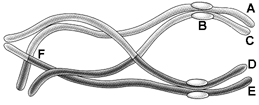Which organism(s) ferment milk lactose, producing acids that curdle the milk?
A) Streptococcus lactis and Lactobacillus
B) Spirulina
C) Propionibacterium
D) Leuconostoc mesenteroides
E) Saccharomyces cerevisiae
A) Streptococcus lactis and Lactobacillus
You might also like to view...
In individuals with normal blood sugar levels, glucose is reabsorbed into the bloodstream in the kidney by members of the GLUT transporter family, which form an aqueous pore across the membrane through which glucose can move passively. As a result, no glucose is excreted in urine. However, in people with untreated diabetes mellitus, blood sugar levels are high and glucose is often present in the
urine. What can explain this occurrence? A. High blood glucose levels reverse the concentration gradient, allowing untransported glucose to be excreted in urine. B. High blood glucose levels interfere with the coupled transport of water and glucose, allowing untransported glucose to be excreted in urine. C. The GLUT transporters become saturated, allowing untransported glucose to be excreted in urine. D. The GLUT transporters cannot hydrolyze ATP quickly enough for ATP to transport the extra glucose, thereby allowing untransported glucose to be excreted in urine.
The process by which a cell takes in large particles, such as other cells, is known as ______.
a. pinocytosis b. phagocytosis c. exocytosis d. receptor-mediated endocytosis
Refer to Figure 10-1. Which of the following combinations of letters accurately represents two
homologous chromatids?
a. A and B
b. A and C
c. A and D
d. B and F
e. D and E
The long-term regulation of arterial blood pressure involves the
A) release of hormones over a period of minutes. B) stimulation of an increase in urine flow through the kidneys. C) immediate change in activity of the nervous system. D) control of blood volume by the kidneys. E) control of peripheral resistance